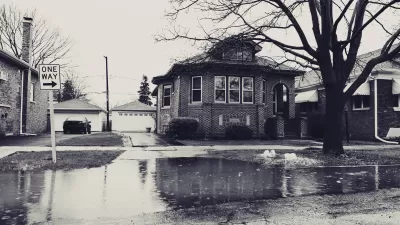In many cities, stormwater and sewage water are collected in the same sewer. As a result, good rainwater is combined with dirty sewage water. Overflows can create major problems for cities. But avoiding those problems is not exactly easy.
Kate Zidar writes about her group's effort to turn a piece of Brooklyn roadside vegetation into a stormwater collection area to help the city avoid sewage overflows during heavy rains.
"Most runoff flows directly into the city's combined sewer, and once the stormwater is in the sewer, you've pretty much lost your chance to do anything useful with it. And one way or another, we have to pay: we either pay to treat it like sewage – which it is not – at the sewage treatment plant, pay for it ecologically when it overflows with a mixture of sewage into local waterways, or pay for it in that big picture way when, by breaking natural environmental cycles, we perpetuate chronic ills such as urban heat island effect. So what can we do? Interventions that might help alleviate the problem require the support and approval of multiple agency gatekeepers. The Department of Transportation has to uphold the integrity of the curb, the Department of Parks and Recreation has to sign off on planting, and the Department of Environmental Protection has to inspect specific stormwater overflow mechanisms.
In short, when North Brooklyn Compost Project became interested in testing a stormwater management strategy on a block in Williamsburg, we found that everybody liked the idea, but nobody could say yes."
Now, Zidar is running a competition to find creative and implementable ideas for dealing with stormwater.
FULL STORY: Minds in the Gutter

Planetizen Federal Action Tracker
A weekly monitor of how Trump’s orders and actions are impacting planners and planning in America.

Maui's Vacation Rental Debate Turns Ugly
Verbal attacks, misinformation campaigns and fistfights plague a high-stakes debate to convert thousands of vacation rentals into long-term housing.

Restaurant Patios Were a Pandemic Win — Why Were They so Hard to Keep?
Social distancing requirements and changes in travel patterns prompted cities to pilot new uses for street and sidewalk space. Then it got complicated.

In California Battle of Housing vs. Environment, Housing Just Won
A new state law significantly limits the power of CEQA, an environmental review law that served as a powerful tool for blocking new development.

Boulder Eliminates Parking Minimums Citywide
Officials estimate the cost of building a single underground parking space at up to $100,000.

Orange County, Florida Adopts Largest US “Sprawl Repair” Code
The ‘Orange Code’ seeks to rectify decades of sprawl-inducing, car-oriented development.
Urban Design for Planners 1: Software Tools
This six-course series explores essential urban design concepts using open source software and equips planners with the tools they need to participate fully in the urban design process.
Planning for Universal Design
Learn the tools for implementing Universal Design in planning regulations.
Heyer Gruel & Associates PA
JM Goldson LLC
Custer County Colorado
City of Camden Redevelopment Agency
City of Astoria
Transportation Research & Education Center (TREC) at Portland State University
Jefferson Parish Government
Camden Redevelopment Agency
City of Claremont



























